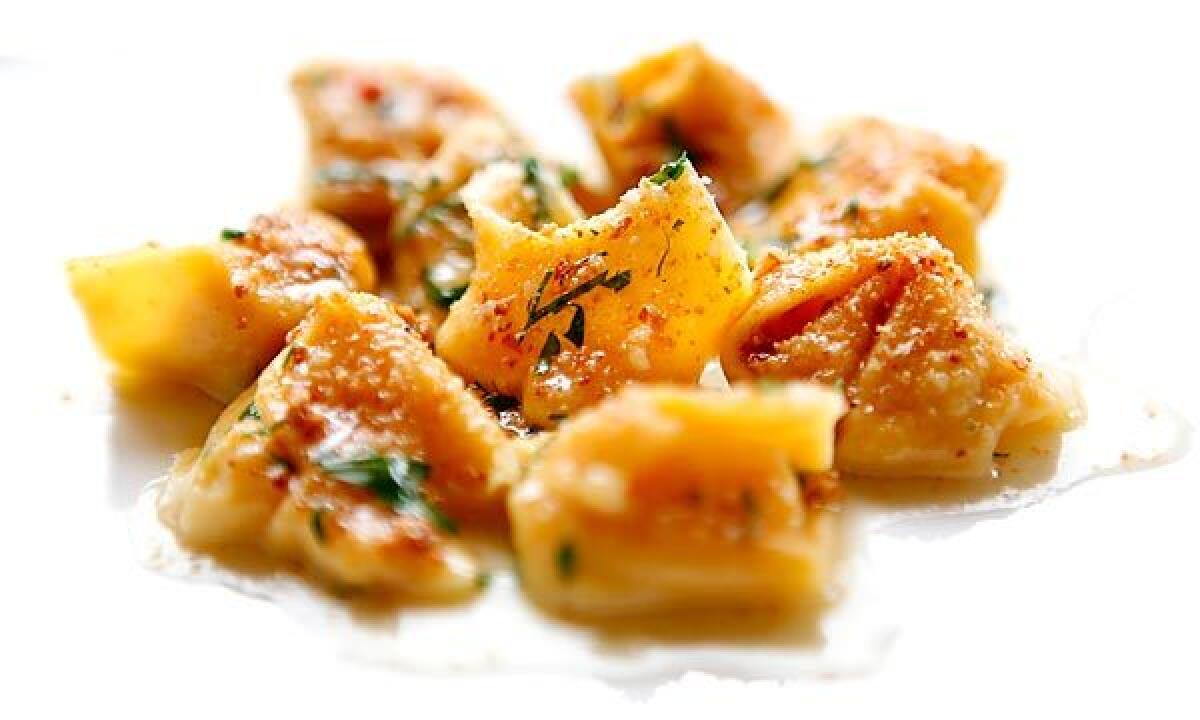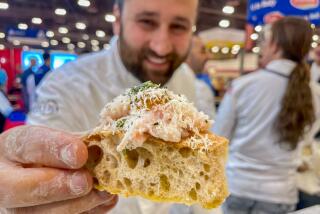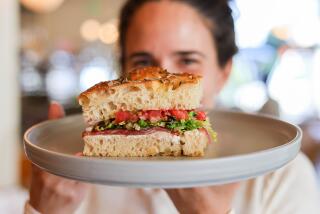The Review: Scarpetta at Montage Beverly Hills

For a long time, Los Angeles chefs had the city to themselves. Outsiders might have turned up for a guest chef turn or two, but never much more than that. But then a couple of years ago that all changed, and Los Angeles was suddenly as attractive as Las Vegas to restaurateurs with satellite restaurants to shop. Fancy that.
And now, following Thomas Keller (Bouchon), Tom Colicchio (Craft), Laurent Tourondel (BLT Steak), and José Andrés (Bazaar), to name a few, comes Scott Conant with Scarpetta, the fourth iteration of his high-end Italian restaurant in New York’s meatpacking district. (A fifth just opened in Las Vegas.)
A much-admired chef, Conant made a name at L’Impero in New York before opening Scarpetta in 2008. Five restaurants in just two years is not exactly a snail’s pace. They’re strung out all over the country, making running them a challenge. He needs a strong organization and enough talent coming up to fill all those chef slots.
So far, the kitchen at his new Beverly Hills restaurant is performing up to speed with a menu that closely resembles the original but has hardly changed a dish since the restaurant opened in late October. Some of the food is wonderful, and impeccably executed for such a new team, even if it weighs in on the side of elegance over soul.
The space at the Montage hotel features a broad outdoor terrace facing Bouchon across a pocket park. The dining room is a bit formal and chilly in tone, but that falls away once you’re seated at a spacious round booth under the shelter of a hanging lamp so large it turns each table into a world unto itself.
Flavor and texture
Bathed in the pale golden light, we dig into a bread basket heaped with fluffy focaccia, spongy white bread and thick slices of a stromboli-like loaf spiraled with cheese and salami. The trio of condiments for the bread — Tuscan olive oil, mascarpone with butter and red-purple eggplant caponata served like a relish — take the edge off your hunger with their bright, focused flavors.
Truffled beef crudo is hand-cut, molded into a cylinder and topped with a thatch of fine julienned white truffles and a pinch or two of grated Parmigiano. There’s some hazelnut too, for crunch. The taste of warm fluffy, buttered toasts topped with the cool beef and that flirt of truffles is simply wonderful. Roll-ups of tuna susci are savory and light, but I think the raw yellowtail crudo drizzled with ginger oil and embellished with pickled red onion is more unusual.
That night, we were seriously in need of comfort food. For Italians (or would-be ones), that inevitably means pasta. Good thing, because this kitchen excels at it. These pasta dishes are elegant, citified takes on regional classics. Cappellacci (a stuffed pasta similar in shape to tortellini) stuffed with pumpkin are terrific. The pasta is al dente, the elements in the filling — the pumpkin, the crushed amaretti cookies, the pepperoncino and cheese — in exquisite balance. But it’s the texture that captivates, each bite slightly different from the next.
Pumpkin also appeared in toasted spelt pasta alla chitarra (the sheet of pasta is cut on a wooden box strung with strings much like a chitarra, or guitar, giving it a square profile instead of round). The spelt grain has a robust, nutty taste that plays well with soft cubes of pumpkin, silky porcini and sharp Asiago cheese. The flavors are autumnal, perfect on a rainy night.
Truffles done right
The real splurge, though, is a plate of Piemontese-style tajarin with white truffle shaved over it at table.
Rarely are white truffles worth it in the United States. If they’re not super fresh, the taste and aroma is a shadow of what they once were for something that’s very, very expensive. Some chefs try to amp up the flavor with truffle oil, always a bad idea. But these tartufi are beautiful, as fragrant as any you’d get in Alba, the heart of white truffle country. And the tajarin is pretty perfect too, though not as eggy as is traditional in Piemonte, where cooks can use a couple of dozen yolks in one batch.
Pasta is clearly the standout at Scarpetta, as it was at L’Impero. I’ve never eaten at the original Scarpetta, but the menu here is very similar to the others: succinct and seasonal, more elaborate than simple. Multiple editions of the same restaurant is a model that Wolfgang Puck established long ago. And it’s not going away anytime soon.
Not everything works as well. One of Conant’s signature dishes is the $24 spaghetti. Spaghetti never looked quite so elegant, presented in a tall swirl, each strand of noodle perfectly cloaked in fresh tomato and basil sauce kicked up with basil-infused olive oil and a smidgen of pepperoncino. The execution is dead on, the taste subtle, like tomato sauce that’s gone to finishing school. What’s missing, though, is the tooth of best-quality dried durum wheat pasta, which is what spaghetti is, after all. This pasta, probably fresh, is softer. In elevating the simple spaghetti, he’s lost some of its soul.
But then who ever expected hotel restaurants to have soul? Their mission is to provide sleek, contemporary dishes for clients who wouldn’t blink at paying $24 for a (small) dish of pasta. And Conant delivers on that front.
He certainly has a talent for making his dishes pop visually. There’s an autumn salad composed of lovely shapes and colors, flaps of black trumpet mushrooms and a subtle foie gras emulsion. Stracciatella, a very soft, creamy mozzarella used to stuff burrata, arrives with lightly grilled figs and little bouquets of greens, arranged like a salad made by a master florist, accented by a fabulous dark fuchsia beet jus casually splashed on the plate like drops of blood—gorgeous against the snowy cheese. Conant also thinks about textures, and micro-croutons scattered over top are the perfect contrast to all that creaminess.
Ash-spiced venison loin is another signature dish. It plays the dark meat’s complex gaminess against bitter braised radicchio and a dried cherry reduction. Everything on the plate resonates and works with every other element. The other main course that stands out is pancetta-wrapped veal loin with sweetbreads, both beautifully cooked and a great match with a stellar Chianti or Valpolicella.
As seems to be typical with Italian restaurants though, other main courses fall flat, like the tough aged sirloin of beef or the correct but dull roasted duck breast with raisin mostarda. They’re fine but just not compelling enough at this price.
But then a hotel restaurant like Scarpetta at the Montage is less about presenting a chef’s singular vision than constructing a menu that offers something for everyone, even the most finicky eater, without condescending.
Conant may be proceeding cautiously until he gets to know Los Angeles better. For now, the kitchen has the execution down. He’s got a great spot, with an inviting outdoor terrace. And he has a style of Italian cooking that has a polish and elegance very different from other Italian restaurants in town. The question is whether Scarpetta Beverly Hills will evolve into something with its own vivid personality or remain merely a very good rendition of the original.
SCARPETTA
RATING: Two-and-a-half stars
LOCATION: Montage Beverly Hills, 225 N. Cañon Drive, Beverly Hills; (310) 860-7970; https://www.montagebeverlyhills.com.
PRICE: First courses, $14 to $18; pasta, $23 to $27 (tajarin with white truffles, market price); main courses, $24 to $34; desserts, $11. Corkage fee, $35, one bottle max per table.
DETAILS: Open for lunch 11:30 a.m. to 3 p.m. daily; for dinner 5:30 to 11 p.m. Sunday to Thursday, and 5:30 p.m. to midnight Friday and Saturday. Valet parking, $8, available adjacent to the Beverly Canon Gardens or through the front entrance of the hotel.
Rating is based on food, service and ambience, with price taken into account in relation to quality. ****: Outstanding on every level. ***: Excellent. **: Very good. *: Good. No star: Poor to satisfactory.
More to Read
Eat your way across L.A.
Get our weekly Tasting Notes newsletter for reviews, news and more.
You may occasionally receive promotional content from the Los Angeles Times.






